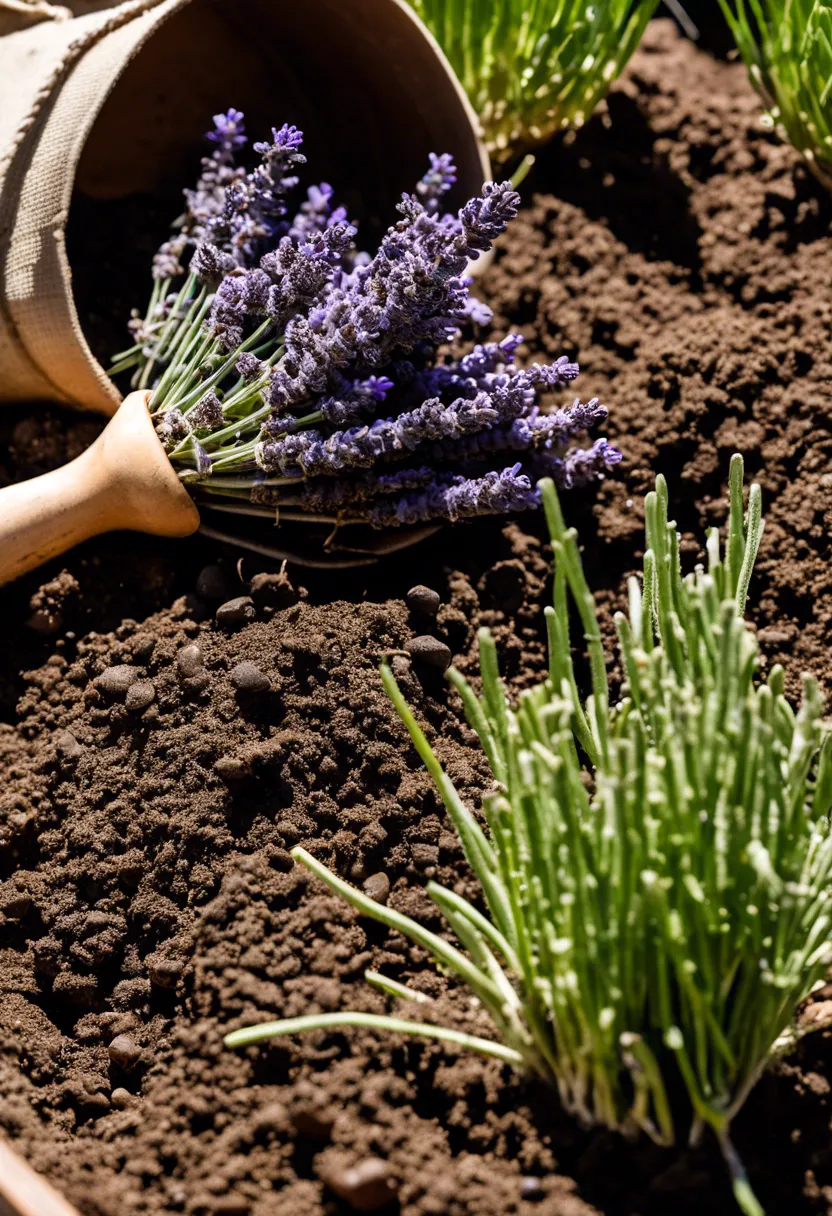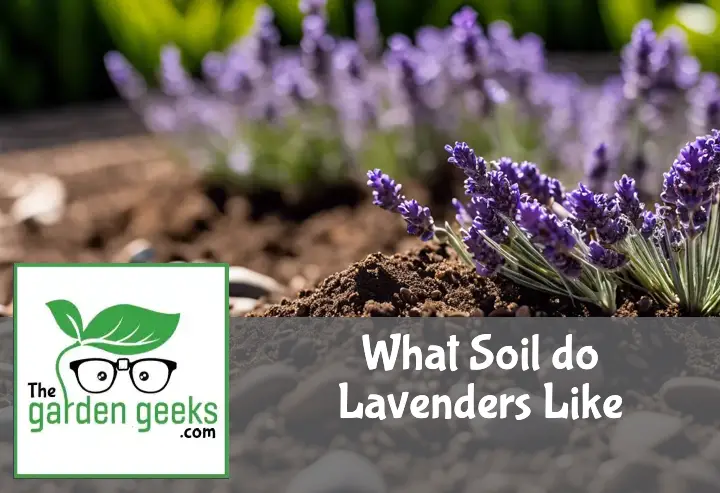Ever wondered what makes those lavender fields in Provence so lush and fragrant? Well, it’s all about the Soil for Lavenders.
Lavender, with its vibrant purple blooms and intoxicating scent, is a favorite among gardeners worldwide. But to truly thrive, these plants require a specific type of soil.
In this blog post, we’ll delve into the world of lavender cultivation and reveal the secrets behind the ideal soil conditions for this aromatic herb. So buckle up and keep reading about Soil for Lavenders!
Key Takeaways
- Lavenders love well-drained, slightly alkaline soil with a pH between 6.7 and 7.3.
- They’re not picky about fertility but do need some organic matter.
- Sandy or gravelly soils are their favorites, but they can tolerate clay if it’s well-drained.
- Overwatering is a no-no; these plants like to be on the dry side.
- Mulching with white pebbles can help reflect light onto the plant and keep roots cool.

Understanding Lavender Plants
Lavenders, with their enchanting fragrance and vibrant hues, are more than just pretty faces in the garden. They’re botanical survivors, thriving where others might falter, thanks to one critical factor: the soil for lavenders.
Origin and Natural Habitat of Lavenders
Lavenders whisper tales of ancient lands and rugged terrains. Originating from the Mediterranean, these resilient plants have adapted to a life of sun-soaked days and breezy nights. The lavender origin story is not just a tale of survival but also of conquest, as these plants spread their roots across Europe and beyond. The natural habitat of lavender, characterized by well-drained soils and open spaces, has shaped their cultivation needs today.
Transitioning from history to geography, it’s fascinating how the geographical distribution of lavenders mirrors their adaptability. From the rocky outcrops of the Mediterranean to the rolling hillsides of England, growing lavenders has become a global affair. This widespread cultivation underscores the importance of mimicking their natural habitat—especially the soil conditions—to ensure thriving lavender gardens.
General Plant Characteristics of Lavenders
Lavenders are nature’s paradox—delicate in appearance yet tough in spirit. Their slender stems crowned with vibrant purple flowers are iconic. The physical attributes of lavenders, including their silvery-green foliage, not only add aesthetic value but also serve practical purposes like deterring pests.
As we delve into the growth habits of lavenders, it becomes clear that these plants are all about resilience. They flourish in environments that would challenge less hardy species, demonstrating remarkable drought tolerance once established. This resilience influences their care requirements for lavenders, emphasizing minimal intervention for maximum bloom.
Importance of Soil to Lavender Growth
The secret to lush lavender fields lies beneath the surface—in the soil itself. Lavender doesn’t ask for much, but it demands well-draining soil to thrive. This preference isn’t just a whim; it’s rooted in survival instinct. In their native habitats, lavenders grow in sandy or gravelly soils where water runs free and roots breathe easy.
Moving on to detailing preferred conditions, it’s clear that optimizing soil for lavender growth involves striking a delicate balance between drainage and nutrition. While these plants disdain wet feet—a sure recipe for root rot—they do appreciate a bit of nourishment from time to time. Incorporating organic matter into the soil can improve its structure while still ensuring that water doesn’t linger too long around lavender’s roots. Achieving this balance is key to fostering healthy lavender plants capable of captivating senses season after season.
What Kind of Soil do Lavenders Like?
Lavenders are not just pretty faces; they’re picky eaters when it comes to the soil for lavenders. They demand specific conditions to flourish, including the right pH levels, texture, and nutrients.
Ideal Soil pH for Lavenders
Let’s talk about the soil’s pH level first. Imagine your lavender plants are Goldilocks; the soil can’t be too acidic or too alkaline. The sweet spot? A lavender pH level ranging from 6.5 to 7.5. This optimal pH for lavender growth ensures that nutrients are readily available for the plants to absorb.
But what if your garden soil isn’t quite there yet? No panic! Adjusting soil pH for lavenders is like tweaking a recipe to perfection. If your soil is on the acidic side, adding garden lime can raise the pH. On the flip side, if it’s too alkaline, sulfur will help lower it down to those ideal acidity levels for lavenders.
Remember, getting your garden soil pH right is not an overnight affair. It’s more like a slow dance with your lavender plants leading. Regularly test your soil and adjust as needed because happy lavenders mean a happy gardener!
Preferred Soil Texture for Lavenders
Now onto the dirt about dirt: texture matters—a lot! Lavenders thrive in well-draining soil because they hate having “wet feet.” The dream home for these plants is sandy loam texture land.
Why sandy loam, you ask? Because it’s like a cozy bed that’s soft yet supportive—providing excellent drainage while holding enough moisture and nutrients. But if your garden isn’t naturally blessed with this ideal lavender planting condition, don’t throw in the trowel just yet!
Improving garden soil texture is doable by mixing in sand and organic matter like compost or aged bark. This DIY mix creates those perfect drainage requirements for lavenders, ensuring they won’t drown after a heavy rainstorm.
Nutrient Requirements in the Soil for Lavenders
Nutrients are where things get a bit tricky because lavenders aren’t greedy feeders. They prefer their soil for lavenders lean rather than loaded with nutrients. Too much of a good thing (like nitrogen) can lead to lush leaves but few flowers—definitely not what we want!
The key essential nutrients for lavenders include moderate levels of nitrogen at planting time and potassium which helps with flower production. Phosphorus? Not so much; these plants are low-maintenance lovers in that department.
If you suspect your lavender babies are nutrient-starved, a light hand with organic fertilizers for lavender can give them a boost without tipping into over-fertilization territory. Remember, less is more here; think of fertilizing lavenders correctly as lightly seasoning food rather than dousing it in sauce.
In summary, achieving nutrient-rich soils for lavenders doesn’t mean bombarding them with every fertilizer under the sun but maintaining a balanced diet that supports healthy growth without overwhelming them.



How to Prepare the Ideal Soil for Growing Lavender


Creating the perfect soil for lavenders involves understanding their unique needs, from the right pH balance to impeccable drainage. Let’s dive into how you can prepare your garden bed and amend existing soil to meet these lavender soil requirements.
Step-by-Step: Preparing Your Garden Bed for Planting Lavender
First things first, choosing where your lavender will live is crucial. You’ll want a spot that gets plenty of sunshine because lavender loves basking in the sun just as much as we do. Assess the site carefully; it should be like real estate – location, location, location! Ensure it’s not a waterlogged area or one that becomes the neighborhood pool after a rainstorm.
After picking the perfect spot, it’s time to roll up your sleeves and get dirty – literally. Weeds are like those uninvited guests at parties; they just show up without notice. Removing weeds before planting is essential because you don’t want them stealing all the nutrients meant for your lavender. Get them out by their roots to ensure they don’t make an unwelcome comeback.
Now, let’s talk about making your soil feel like a cozy bed for your lavender. Enhancing soil drainage is key because lavender hates having wet feet – it’s quite picky about its pedicure environment! Mixing in some sand or gravel can help improve drainage, making sure water flows through smoothly without overstaying its welcome.
Amending Your Existing Soil to Suit Lavender
So you’ve got soil already but it’s not quite ready for a lavender plant? No worries, amending your existing soil can turn it into a welcoming home for those fragrant purple blooms. Understanding why this step is crucial sets the stage for successful lavender growth. It’s all about creating that “just right” environment – think Goldilocks but with soil.
If you’re dealing with clay soil that holds onto water like a sponge, adding coarse sand or gravel can break up the density and encourage better drainage. Remember, we’re aiming for well-drained conditions where water doesn’t linger too long.
For those with sandy soils that let water slip through too quickly, incorporating organic matter can be a game-changer. It helps retain just enough moisture without causing waterlogging, creating an ideal balance for thriving lavender plants.
Adjusting the pH level is another critical aspect of amending soil for lavender growth. Lavender prefers slightly alkaline conditions, so if your soil is on the acidic side, consider adding some lime to sweeten it up a bit. This adjustment ensures that nutrients are readily available to your plants, promoting healthy growth and vibrant blooms.
By addressing these specific needs – whether breaking down heavy clay or enriching sandy plots – you’re setting the stage for lush lavender fields (or gardens) that not only thrive but become the envy of every plant lover around.
Common Mistakes in Choosing and Preparing Soil for Lavender
Choosing the right soil for lavenders isn’t just about digging a hole and planting them. It’s an art mixed with a bit of science. Over-fertilizing and using poorly draining soils are like giving your plants a one-way ticket to struggle town.
Over-Fertilizing the Soil
Lavenders are like those folks who thrive on minimalism; they don’t need much to be happy, especially not an abundance of nutrients. When you go overboard with fertilization, it’s like feeding them a feast when they asked for a snack. This excessive soil fertilization can lead to lavender plant damage, making them weak and less fragrant.
The signs of over-fertilizing aren’t always immediate but keep an eye out for slow growth or yellowing leaves. If you suspect you’ve been heavy-handed with the feed, don’t panic! Correcting soil fertility starts with watering to flush out excess nutrients and holding off on any more fertilizer. Remember, lavenders prefer tough love when it comes to their diet.
Using Poorly Draining Soils
Imagine wearing wet socks all day; that’s how lavenders feel in waterlogged soil. These plants despise having ‘wet feet’ because it leads to all sorts of trouble like root rot, which is as nasty as it sounds. Lavender root health is paramount for thriving plants, so ensuring your garden has good drainage is non-negotiable.
If you’re cursed with clay or compacted soil, don’t despair! Improving garden drainage might involve adding organic matter or creating raised beds to elevate your lavenders above any potential waterlogging. Think of it as setting up a drainage system in your garden – a little effort goes a long way in preventing root rot in lavender and securing those aromatic blooms we all love.


To Wrap Up
So, you’ve made it to the end of our deep dive into the world of Soil for Lavenders. We’ve learned that lavenders thrive in well-drained, sandy or gravelly soils with a neutral to slightly alkaline pH.
Remember, overwatering and heavy clay-like soil can lead to root rot which is a death sentence for these purple beauties. So, keep it light and airy!
Finally, don’t forget to show your lavender some love. With the right soil and care, your garden will be an aromatic paradise in no time! Happy planting!


